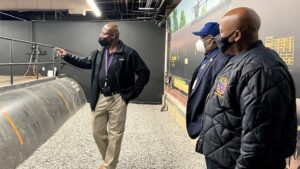
FEMA’s Center for Domestic Preparedness this week hosted a senior level focus group of executives from the Black Chief Officers Committee (BCOC).
The BCOC is comprised of more than 500 black chief officers in the United States, United Kingdom, Africa and the Caribbean who work to improve the educational and other professional development of minority fire and emergency services personnel.
During their two-day visit, the executives discussed training opportunities at the CDP, the National Domestic Preparedness Consortium, and the Emergency Management Institute, and heard virtually from representatives from several other FEMA activities, including the U.S. Fire Academy, the Center for Faith Based and Neighborhood Partnerships, and the agency’s Grant Program Directorate.
They also toured two of the CDP’s preeminent training platforms — the Chemical, Ordnance, Biological and Radiological (COBRA) Training Facility and Advanced Responder Training Complex (ARTC).
The COBRA Training Facility has the only program in the nation where civilians can train with hazardous biological materials and toxic chemical agents. It enables responders to build the confidence and competence to effectively respond to real-world incidents involving biological, chemical, explosive, radiological and other hazardous materials.
The ARTC prepares responders to deal with a wide range of man-made and natural hazards in settings commonplace in communities across the nation. Among other things, it has an industrial park, a mock subway station, and a simulated street scene with businesses and warehouses.
The chairperson of the BCOC, Joe Dixon, fire chief of the Gainesville, Florida, Fire Rescue department — said he was happy to “collaborate with the CDP to make a difference” in the lives of those the group serves.
CDP Superintendent Tony Russell echoed those comments, noting his vision for the partnership is to identify tangible steps the two parties can take to increase the number of minority firefighters who train at the CDP and, ultimately, “change outcomes” in historically underserved communities.
